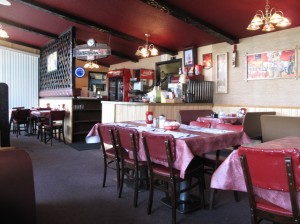 Whenever I asked a local where to get the best taste of the St. John Valley (or St. Jean, if you’re French)—that strip of Acadian culture separated from New Brunswick, Canada, by the St. John River—the answer was always a variation of: “You must go to Dolly’s for the best ployes, creton, and chicken stew.”
Whenever I asked a local where to get the best taste of the St. John Valley (or St. Jean, if you’re French)—that strip of Acadian culture separated from New Brunswick, Canada, by the St. John River—the answer was always a variation of: “You must go to Dolly’s for the best ployes, creton, and chicken stew.”
And so I went.
Twice.
Backstory: I’ve been cruising through Downeast Maine and Aroostook County for the past week researching the new edition of Moon Maine (spring 2011), and I’m finally home and in one place long enough (and with reliable Internet access) to start dishing on my finds and giving you updates on what’s happening in these rural Maine gems.
 When first told that Dolly’s was a must, we headed right there. Unfortunately, it was a Tuesday, when it’s closed. Now frankly, Dolly’s, on Route 1 in Frenchville, isn’t much to look at from the outside, and we hadn’t planned to return, but as we continued down the road and kept asking, the answer remained Dolly’s. So we made a 70-mile detour to return for breakfast on Wednesday, and oh! my! yes!
When first told that Dolly’s was a must, we headed right there. Unfortunately, it was a Tuesday, when it’s closed. Now frankly, Dolly’s, on Route 1 in Frenchville, isn’t much to look at from the outside, and we hadn’t planned to return, but as we continued down the road and kept asking, the answer remained Dolly’s. So we made a 70-mile detour to return for breakfast on Wednesday, and oh! my! yes!
Now we couldn’t order that famous chicken stew at breakfast, but we did have Dolly’s homemade ployes (rhymes with toys) and homemade creton (cray-tahn).
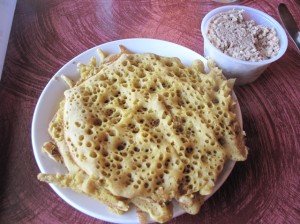 Say what? you ask. Ployes—French-Acadian buckwheat pancakes cooked only on one side—are traditionally served like bread with every meal. And creton is a French-Canadian meat spread. Put the two together, and perhaps add a bit (or more) real maple syrup, and the result is heaven. I like to think the health benefits of the ployes cancel out the artery-busting creton.
Say what? you ask. Ployes—French-Acadian buckwheat pancakes cooked only on one side—are traditionally served like bread with every meal. And creton is a French-Canadian meat spread. Put the two together, and perhaps add a bit (or more) real maple syrup, and the result is heaven. I like to think the health benefits of the ployes cancel out the artery-busting creton.
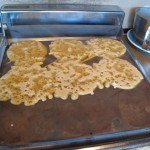 “Dolly’s has been here forever,” our waitress said, as I watched her pour the batter onto the griddle and cook the ployes. The reason Dolly’s ployes are so good is that they’re made from scratch. “It’s an old recipe, and they’re homemade,” she said. “I make ployes at home, and it took me a long time to get the recipe and the cooking right.” The biggest problem is getting the griddle temperature right. “They’re so easy to burn,” she said. The creton, too, is a secret recipe.
“Dolly’s has been here forever,” our waitress said, as I watched her pour the batter onto the griddle and cook the ployes. The reason Dolly’s ployes are so good is that they’re made from scratch. “It’s an old recipe, and they’re homemade,” she said. “I make ployes at home, and it took me a long time to get the recipe and the cooking right.” The biggest problem is getting the griddle temperature right. “They’re so easy to burn,” she said. The creton, too, is a secret recipe.
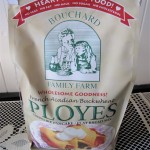 Earlier in the week, I’d purchased copy of Michael Corbin’s Cafe de la Place cookbook (Unfortunately, his downtown Madawaska restaurant is no more). It has a recipe for ployes that I plan to make, but I also purchased a bag of Bouchard Family Farms ployes mix, too. The farm, in Fort Kent, has long been producing this easy-to-make mix, which you can usually find in specialty and natural foods stores.
Earlier in the week, I’d purchased copy of Michael Corbin’s Cafe de la Place cookbook (Unfortunately, his downtown Madawaska restaurant is no more). It has a recipe for ployes that I plan to make, but I also purchased a bag of Bouchard Family Farms ployes mix, too. The farm, in Fort Kent, has long been producing this easy-to-make mix, which you can usually find in specialty and natural foods stores.
The Acadians, by the way, are descendants of the original French settlers in Grand Pre, Nova Scotia, who were driven out by the English. Some returned to France, others escaped to New Orleans (where they’re known as Cajuns), and others escaped and scattered throughout Maritime Canada. Twelve families eventually settled in the St. John Valley, where their heritage still flavors the region. More on this in future posts.
And next time I’m up in the crown of Maine, I’ll time my visit to Dolly’s to have some of that famous chicken stew.
Note: Check out my review with recipes of the Bouchard Family Farms French-Acadian Cookbook: Keeping the Tradition Alive.



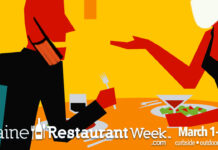










Stop you’re making me hungry. Dolly’s sounds like a place I must visit soon.
I love these kinds of places. Glad you turned around!
St. John Valley, not St. Jean Valley. At first I thought it was a typo, but you did it twice (just want to make sure you get it right for your guidebook!)
Hi Mike,
I’m using the French spelling to reflect that heritage. Could use either. Thanks.
I’ve never heard that…and I’m from the area! Everybody calls it the St. John Valley – same as the river it’s named after (it may sound different when said with a French accent). Is that what you were told up there?
Google St. Jean Valley…nothing comes up. Now google St. John Valley.
Though I should say, I suppose it depends on whether or not you are speaking French. Then it would be Vallee St-Jean. Just like it would be Riviere St-Jean.
Hmm, since you’re a local…
Hilary, you are good and decent person. I don’t know what I’d do if I had every Tom, Dick, and Harry critiquing my work. I wasn’t as concerned about your blog as I was your guidebook really. I’m relentless in my defense of The County.
BTW, did you get to visit the Long Lake Sporting Club? Haven’t been there in years but it’s often on my mind.
Mike, I noodled just about every road in The County, and yes, did stop by the LLSC, although didn’t eat there this time–have before, though. My best discovery was the St. Agatha Historical Society Museum. I’ll be posting on that, later, but wow! such a fab collection for such a tiny town. I also stocked up on potatoes at various stands, new reds and new whites. And I purchased Michael Corbin’s cookbook so I can try to replicate ployes and creton. We’ll see…
I miss it up there, I really do. Something always tugging at me I gotta say. So cool that you had some creton, my dad’s from St. Francis and he grew up on the stuff. I used to eat it on toast. To the outsider, it’s really akin to a pork pate. Tasty. The only thing I’ve seen even REMOTELY close around here is the pork pate at Lily, but it’s a different animal really. Lily’s is yummy, but I daresay you’d never see creton in the Valley with pistachios in it.
My mom is from St. Agatha (Ste. Agathe, if you ask HER) and SHE calls it St. JOHN also… not St. Jean… just saying.
Re: Long Lake Sporting Club…ployes come with every meal…
It’s still a great place to get a 5 lb. lobster!
I promise never to use the French pronunciation or spelling again, grin. And yes, Agathe.
Thanks for verifing for me that creton
And ployes are a real breakfast for French-Canadiens. I love them yet most of my “French-Canuck” friends have no idea what I am talking about, and I live in New Hampshire! I can’t wait to get up to “Dolly’s” if I ever get the chance.
My father was born in Van Buren and grew up in the whole stretch from there to Houlton. I was raised in Auburn (not exactly the center of French culture in Maine!) and have just recently realized that much of what I grew up eating was French-Canadian. I just kinda thought everyone in Maine ate it! Geez, I’m 72, you’da thought I’da figured it out a little sooner, wouldn’t ya? Am tired of the “fancied up” cuisine of today and am gonna try fixin’ some of the old, simple, tasty dishes of “the good ol’ days”. Enjoyed the discussion here – please keep me on your good list. Thanks
Am originally from Keegan Maine which is not Van Buren but we brought up with ployes and creton, which is really great. But on Sundays nights after having a roasted chicken for lunch my Mom would stack ployes on our plate and pour the chicken broth over them , how great that was . Many ways to sereve.
Am originally from Keegan Maine which is now Van Buren but we brought up with ployes and creton, which is really great. But on Sundays nights after having a roasted chicken for lunch my Mom would stack ployes on our plate and pour the chicken broth over them , how great that was . Many ways to sereve.
The ployes at Dolly’s are absolutely to die for. I had them as an appetizer for my fish & chips. Definitely worth a try, I’ll be attempting to make ployes myself sometime soon!
I’m laughing to myself over the parts of my French Canadian food heritage I never knew. Cretons were not something I knew, nor were ployes. I grew up in central New England (Keene, NH area), and only knew about tortiere from the family recipes. I learned about cretons when I was researching fishing communities in Massachusetts, and found tourtiere served in a local small restaurant. Then I found the cretons I was served last year in Quebec tasted very similar to the family recipe for tortiere which I have given out. Won’t spill the beans for that one here though!
And I worked up in the area you’re visiting in this description long before you started writing (I was a geologist in the north Maine woods back in the late 70s) so the towns are familiar, and darned if Dolly’s doesn’t sound familiar, too, but I don’t remember them serving ployes!
Comments are closed.